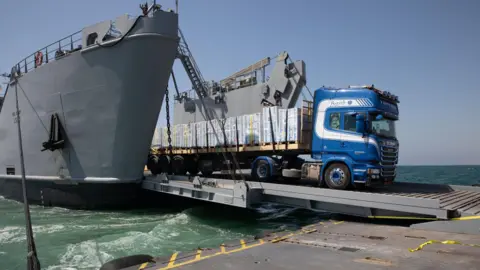US military ends Gaza floating aid pier mission
 Centcom
CentcomThe US military has ended its mission to operate a temporary floating pier to deliver more aid to the Gaza Strip, after it was beset by weather, technical and security problems.
Supplies from Cyprus would now by shipped by US vessels to the Israeli port of Ashdod and then transported by lorry to northern Gaza via an Israeli-controlled crossing, the deputy head of Central Command said.
Vice-Adm Brad Cooper insisted the pier had enabled a “surge” in aid deliveries, noting that more than 9,000 tonnes had been delivered over two months.
However, it was operational for only about 20 days and had been out of action since 28 June because of bad weather.
The UN and other humanitarian organisations have said the total delivered via the pier represents a tiny fraction of the aid required by the 2.2 million Palestinians in Gaza. They say 500 lorries of aid and commercial supplies - equivalent to 10,000 tonnes - are needed daily.
They have also consistently stated - and the US has acknowledged - that the most effective and efficient way to get aid into Gaza is through land routes.
Adm Cooper told reporters that the pier mission had been a "historically unprecedented operation to deliver aid into an active combat zone without any US boots on the ground”.
"Our assessment is that the temporary pier has achieved its intended effect to surge a very high volume of aid into Gaza and ensure that aid reaches the civilians in Gaza in a quick manner," he said.
He also argued that the mission had been cost-effective, saying it had cost less than the initial estimate of $230m (£177m).
The admiral said Israel was fully supportive of the US decision to end the pier mission and “transition” to the port of Ashdod, which is only 30km (19 miles) from northern Gaza.
Sonali Korde of USAid’s Bureau for Humanitarian Assistance said: “The key challenge we have right now in Gaza is around the insecurity and lawlessness that is hampering the distribution once aid gets into Gaza and to the crossing points.”
When the pier began operating in mid-May, US officials suggested it would remain in place until August or September.
But after stormy weather in late May, four landing craft involved in the operation broke loose and were washed ashore. Parts of the pier also had to be taken to Ashdod for repairs.
The whole structure had to be moved to Ashdod three more times over the next month because of bad weather and maintenance before the US military decided to end the mission.
The US was also forced to deny what it said were fake social media reports that Israel had used the pier for a hostage rescue mission in central Gaza on 8 June.
However, resulting security concerns led the UN World Food Programme to stop collecting aid from the holding area next to the pier, leading to thousands of pallets of supplies building up. Eventually, contractors were hired to move the aid to warehouses so it would not spoil.
Last week, US President Joe Biden expressed disappointment with the pier mission, saying: “I was hopeful that would be more successful.”
Mr Biden announced that the pier would be constructed in March, in response to a UN-backed assessment which warned that famine was “imminent” in northern Gaza.
The latest assessment, from the end of June, said the available evidence did not indicate a famine was occurring there, citing an increase in the amount of food and other aid allowed in.
However, it warned that 495,000 people across Gaza were still facing “catastrophic levels” of hunger and that a “high risk” of famine would persist as long as the war between Israel and Hamas continued and humanitarian access was restricted.
UN officials blame the situation on Israeli military restrictions on aid deliveries, the continuing hostilities and the breakdown of law and order.
Israel insists that there are no limits to the amount of aid that can be delivered into and across Gaza and blames UN agencies for failing to distribute supplies. It also accuses Hamas of stealing aid, which the group denies.
